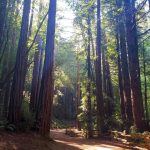Once the setting for a thriving mill town of 400 people, the Headwaters Forest Reserve is now inhabited only by wildlife and fish. The 7,472-acre property was purchased by the Department of the Interior in 1999 to conserve and study the land and its inhabitants and to provide access to the public for recreation. Stands of old-growth redwood and Douglas fir are habitats for the threatened marbled murrelet and northern spotted owl, and threatened coho and chinook salmon can be found in the reserve’s streams.
The mill town, called Falk for its developer, Noah Falk, slowly died out after the mill closed in 1937, and by 1979 most of the buildings had been razed. Except for some sparsely scattered ornamental plants, such as rose, quince, and lilac, that once adorned the houses, there’s virtually nothing visible to remind you that the employees of the Elk River Lumber Company and their families once lived here, although a brochure describing a self-guided “quest” brings this history to life.
The reserve has two trails, Elk River and Salmon Pass, but the latter is open for guided hikes only (May 15-Nov. 15, reservations required) and has no wheelchair access.
Elk River Trail
see access criteria for definitions
Trailhead: Parking lot at the foot of Elk River Rd.
Length: 1-2 total miles
Typical Width: 4 ft. & above
The self-guided Quest Trail is less than three feet wide.
Typical Grade: Gentle
Terrain: Hard
The driveway to the education center is large-sized gravel and the spur trail is firmly packed with dirt and gravel
Obstacles: The approach to the Quest Trail has a steep cross-slope but was not a problem in my motorized wheelchair
Description
The trail follows the South Elk River on an old logging road. Only the first mile is paved; after that, the surface is packed gravel, and on my visit, a washout a short distance beyond the paved section prevented further wheelchair access. It’s evident from the trees’ size that the forest has been logged, and while several large stumps offer a glimpse of their potential size, sadly, they also serve as a reminder of the devastation of old-growth forests. Because this is a relatively young forest, dappled sunlight reaches the trail in many places, while plants characteristic of riparian habitat––willows, maple, alder, ferns––fill the empty spaces. Interpretive panels on metal sculptures that resemble tree branches provide insight into the area’s history. On my mid-September visit, an abundance of blackberries lined the trail, tempting me to indulge, and birdsong mingled with the occasional barking of dogs nearby. Pennyroyal was also plentiful.
About .5 miles down the mostly level trail (there are a few gentle slopes) is a firmly packed dirt-and-gravel spur trail that meanders through woods that are lush with ferns. At first glance, the cross-slope on the approach was discouraging, but my companion handed me a brochure from a nearby wooden box that described a self-guided “quest” through a time when this site was a bustling mill town. I was spurred on, and the cross-slope turned out to be quite manageable in my motorized wheelchair, as did the rest of the trail.
Along this trail you get a first glimpse of the river; in the fall, the flow was barely a trickle. Benches are at a few select viewing spots. I kept looking for numbers to correspond to the clues in the quest brochure and gave up when I couldn’t find them. It wasn’t until I was back at my van, rereading the brochure, that I realized the numbers related to the next quest and not to numbered signposts.
Back on the main trail, in less than an eighth of a mile, you reach the education center. Immediately past the center is the steepest segment, which lasts for several hundred feet. My motorized chair easily climbed this section, and someone with good upper-body strength should have no problem.
The sounds of flowing water became a whisper before I could finally see the river from the trail. Less than half a mile from the education center, the pavement ended with an interpretive sign that explains that if you were standing in this spot in the year 1902, you’d be inside the mill. The unpaved trail looked manageable in a motorized chair, but I didn’t venture farther because dusk was settling in. Later, park staff told me that a washout less than half a mile from this point would have prevented my passage.
Accessibility Details
The facilities listed below meet all of our access criteria unless otherwise noted.
Accessible Visitor Center: Yes
The Headwaters Education Center is .6 miles from the trailhead in a building used 100 years ago by the Falk Mill to store the locomotive that hauled lumber to the mill. In 2008 the building was dismantled and moved here from its former location across the South Fork Elk River. It is primarily open for school visits, but with sufficient funding may be open to the public June through August. Interpretive panels describe the reserve’s ecology and history. For the accessible entrance, go past the building to the dirt and gravel driveway.
Accessible Parking: Yes
Paver stones may be problematic for van ramps
Accessible Restroom: Yes
At the trailhead and next to the education center, about half a mile from the trailhead
Accessible Picnic Tables: Yes
One table at the trailhead and one just beyond the education center. Both are adjacent to the trail, but the setting by the education center is nicer.
Additional Information
Map: See here.
Hours: Daily, sunrise to sunset
Fees: None
Dogs: Only allowed on the Elk River Corridor and must be under voice control of the owner at all times, or on a leash













